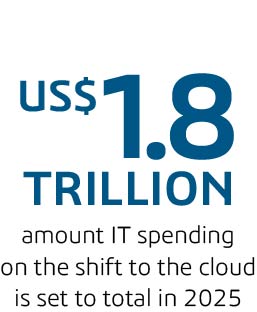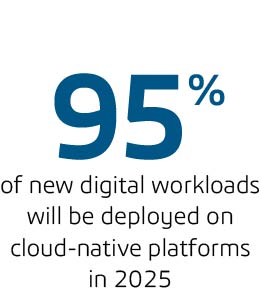People have become well accustomed to online services. Whether it’s streaming music, communicating on social media or working from home, it’s all possible thanks to cloud computing. Organizations increasingly rely on the cloud too – for the productivity of their people, to deliver new services to customers, manage operations and even safeguard their data.
What is cloud computing?
In simple terms, cloud computing is the on-demand access of computing resources like software and storage as a service over the internet, using pay-per-use pricing. Businesses and consumers alike can access technology on an as-needed basis, offering greater flexibility, lower costs, and an ability to scale.
A brief history of cloud computing
Before cloud computing, businesses typically had an on-premises IT infrastructure, including servers, databases and software, at their own physical sites. With cloud computing, these elements are delivered via the internet.
The transition to cloud-based infrastructures began around the mid-1990s, when AOL, Yahoo and Microsoft introduced internet email services. People could access email via a browser, without the need for an email application on their device or email servers in their workplace.
Organizations increasingly provided employees with a range of services – from email to file storage and customer databases – using systems that were hosted on remote servers, or ‘the cloud’.
Businesses like Amazon, Google and Microsoft started using the term to describe a new IT business model in the 2000s and the cloud has rapidly become the de facto means of delivering not just software, but also platforms and entire technology infrastructures, as a service.

By 2021, over two-thirds (68%) of enterprises spent over US$2.4 million on cloud technology, and 36% invested over US$12 million, according to the 2021 State of the Cloud Report from IT management provider Flexera. That number is continuing to rise sharply, with Gartner predicting that IT spending on the shift to the cloud is set to total almost US$1.8 trillion in 2025.
What is cloud computing architecture?
Cloud computing architecture refers to the components that interact to make a cloud computing environment. This includes hardware, software, resources, networking and a delivery model. Together they enable organizations and individuals to store, access and share data from anywhere.
Cloud architecture is the modern way of building computer systems. It hides the complicated stuff like how computers ‘talk’ to each other, the physical machines they run on, and security measures, to deliver a trustworthy and flexible service that allows organizations to focus on their primary activities.
What does a cloud architect do?
A cloud architect is an IT expert responsible for shaping and managing a company’s cloud computing strategy. Their role includes creating cloud adoption plans, designing cloud applications, and ensuring effective cloud management and monitoring. Cloud architects oversee the deployment and architecture of public, private, and hybrid clouds, ensuring that the infrastructure aligns with the organization’s goals. Their primary focus is on scalability, performance, security and cost efficiency, ensuring the cloud solutions meet business needs seamlessly.
A cloud architect plays a critical role in modern organizations as businesses increasingly rely on cloud solutions for agility and innovation. Their expertise ensures that cloud systems are not only efficient but also resilient to evolving demands. By prioritizing scalability and security, cloud architects help companies stay competitive while protecting sensitive data. Moreover, their focus on cost efficiency ensures that businesses maximize their return on investment in cloud technologies. Without a skilled cloud architect, companies risk inefficiencies, vulnerabilities, and missed opportunities for growth.
What does cloud computing architecture look like? Breaking down its components
The components of a cloud computing architecture are considered in terms of a front end and a back end.
Whenever we open a web browser like Google Chrome or Microsoft Bing on our phone or laptop, we are interacting with the front-end platform of cloud computing architecture. The front end consists of both hardware components like the devices we use and software – often a web browser – that provides a graphical user interface (or GUI).
The back-end platform consists of the components that conduct the behind-the-scenes work to deliver the required functionality to the user.
This begins with the application itself – the software that the user is accessing via the front-end.
What are the benefits of cloud computing architecture?
Cloud computing has rapidly increased in popularity because of the multiple and significant benefits it delivers. Most notably, cloud computing can help organizations to reduce costs, upgrade or scale computing resources more easily, improve availability and security and reduce the time required for the deployment of new services.
1. Cost
A cloud computing architecture removes all the costs associated with setting up and managing an organization’s own servers and software, from equipment to energy and expertise. A cloud environment also means only paying for exactly what is used.
2. Flexibility
Changes to services can be made very quickly and easily, allowing companies to scale their operations up (or down) on demand, enabling them to focus on their own business.
3. Security
Cloud providers devote considerable resources to protecting infrastructures against security threats such as hackers and viruses and offer various services for data backup and recovery. However, it is important to mention that responsibility is not entirely transferred to the cloud provider; a shared responsibility exists, and customers have an active role to play in protecting their data. Customers must develop clear security policies and apply them in the context of their use of the cloud through access management, privacy rules and sensitive data classification.
4. Speed
Organizations can deploy new services faster thanks to the ease of switching on new capabilities or capacity in cloud computing environments.
5. Accessibility
Cloud applications and data can be accessed from anywhere in the world, enabling remote working and global expansion.
Many of these benefits are possible because the cloud provider takes care of service delivery. Their expertise and the economies of scale they achieve by doing this for multiple organizations means they can be more efficient and effective than an in-house team.
Businesses of all industries are shifting to cloud computing architectures to reap these benefits. For example, banks are improving fraud detection thanks to the data processing capabilities of the cloud. The healthcare industry is using cloud computing architectures to manage electronic medical records efficiently, retailers can offer seamless services to customers over multiple channels, and manufacturers are improving efficiency with internet-connected machinery.
What are the 4 Types of cloud computing architecture?
There are four primary types of cloud computing architecture: 1. Public, 2. Private, 3. Hybrid, and 4. Multi Clouds.
1. Public cloud architecture
When implementing public cloud architecture, an organization uses cloud computing resources and physical infrastructure owned and operated by a third-party provider such as Amazon Web Services, Google and Microsoft. This is a very popular option, as it means only paying for the services used without having to purchase hardware or software and being able to turn to the cloud service provider for maintenance or scalability issues.
2. Private cloud architecture
Some organizations – particularly those using highly sensitive data, such as financial or legal firms – will opt for a private cloud architecture. This is a dedicated cloud owned and managed by a single organization, giving them more control over resources and increased security over data and infrastructure. These infrastructures are often hosted on-premise but can also reside on an off-site co-location data center.
3. Hybrid cloud infrastructure
A hybrid cloud is an infrastructure that seamlessly integrates public and private clouds to deliver a mix of services. This allows users to migrate workloads between environments and provides the control and visibility of computing, storage and networking resources that characterize the private cloud, alongside the flexibility, scalability and reduced capital cost of the public cloud.
4. Multi Clouds
Multi-cloud strategies are increasingly embraced by enterprises seeking flexibility, reliability, and optimized performance. By leveraging multiple public cloud service providers, businesses can distribute workloads, enhance redundancy, and mitigate risks associated with vendor lock-in. This approach not only empowers organizations to tailor solutions to specific operational needs but also accelerates innovation by tapping into diverse technological capabilities.
4 primary cloud-computing service models
Cloud services are the resources that are made available to the user. There are four primary cloud-computing service models:
1. Software as a service (SaaS): SaaS architecture provides the user with access to software delivered and managed via a third party over the internet. Their use eliminates the need for end-users to deploy the software locally. SaaS applications are accessed via a web interface.
2. Platform as a service (PaaS): In this cloud model, IT teams can access a cloud-hosted platform delivered and managed by a third party, on which they can develop their own software solutions without having to manage applications and data.
3. Infrastructure as a service (IaaS): IaaS provides access to an entire IT infrastructure, where all physical and virtual servers, storage, networking and security are delivered and managed by a third party.
4. Cloud infrastructure and platform services (CIPS): CIPS is a combination of the above two models and is defined by Gartner as “standardized, highly automated offerings, in which infrastructure resources (e.g. compute, networking and storage) are complemented by integrated platform services”.
Other frequently asked questions about cloud computing architecture
What are the five pillars of cloud computing?
Cloud computing is built on five core pillars that form the foundation of effective cloud architecture:
1. Resilience
Ensuring systems can recover quickly and continue operating during disruptions.
2. Operational Excellence
Streamlining processes to maintain reliability, efficiency, and scalability.
3. Performance Efficiency
Optimizing resources to deliver consistent, high-quality performance.
4. Security
Safeguarding data and systems against threats with robust protection measures.
5. Cost Optimization
Managing expenses by maximizing value while minimizing unnecessary costs.

How do you become a cloud architect?
Pursuing a career as a cloud architect requires a solid foundation in computer operating systems, programming languages, networking, and cybersecurity. While a formal degree isn’t mandatory, it can provide a competitive edge. With the cloud computing market expected to surge from $676.29 billion in 2024 to an astounding $2,291.59 billion by 2032, this career path offers immense potential for growth and opportunity.
Final thoughts
Understanding cloud computing architecture is crucial for businesses at any stage of the journey to digital transformation. With the right technology infrastructure in place, organizations are empowered to focus on their core activities.
By 2025, over 95% of new digital workloads will be deployed on cloud-native platforms. It’s clear that cloud computing has fundamentally shifted in how organizations approach IT.
Ready to learn more? Check out Dassault Systemès’ 3DEXPERIENCE platform on the cloud
Related resources:
- Cloud & SaaS Software-as-a-Service Solutions for Manufacturing and Industry
- What is the sovereign cloud?
- Why SaaS is Key to Improving Scalability and Accelerating Innovation
- Supercharge Your Hybrid Workplace with 3DEXPERIENCE Cloud
- Exploring the advantages and benefits of cloud computing
- Cloud sovereignty and investment compliance

